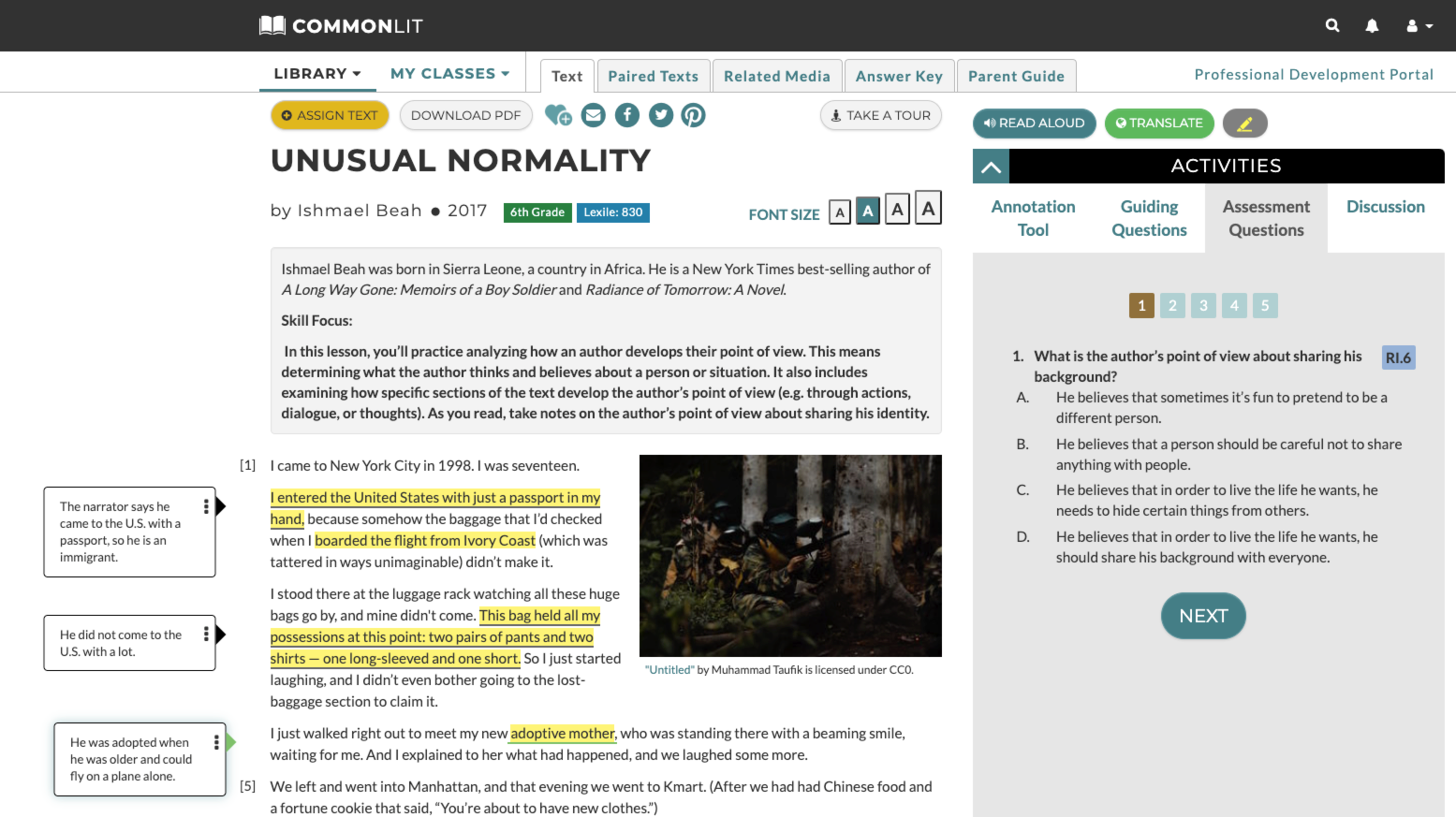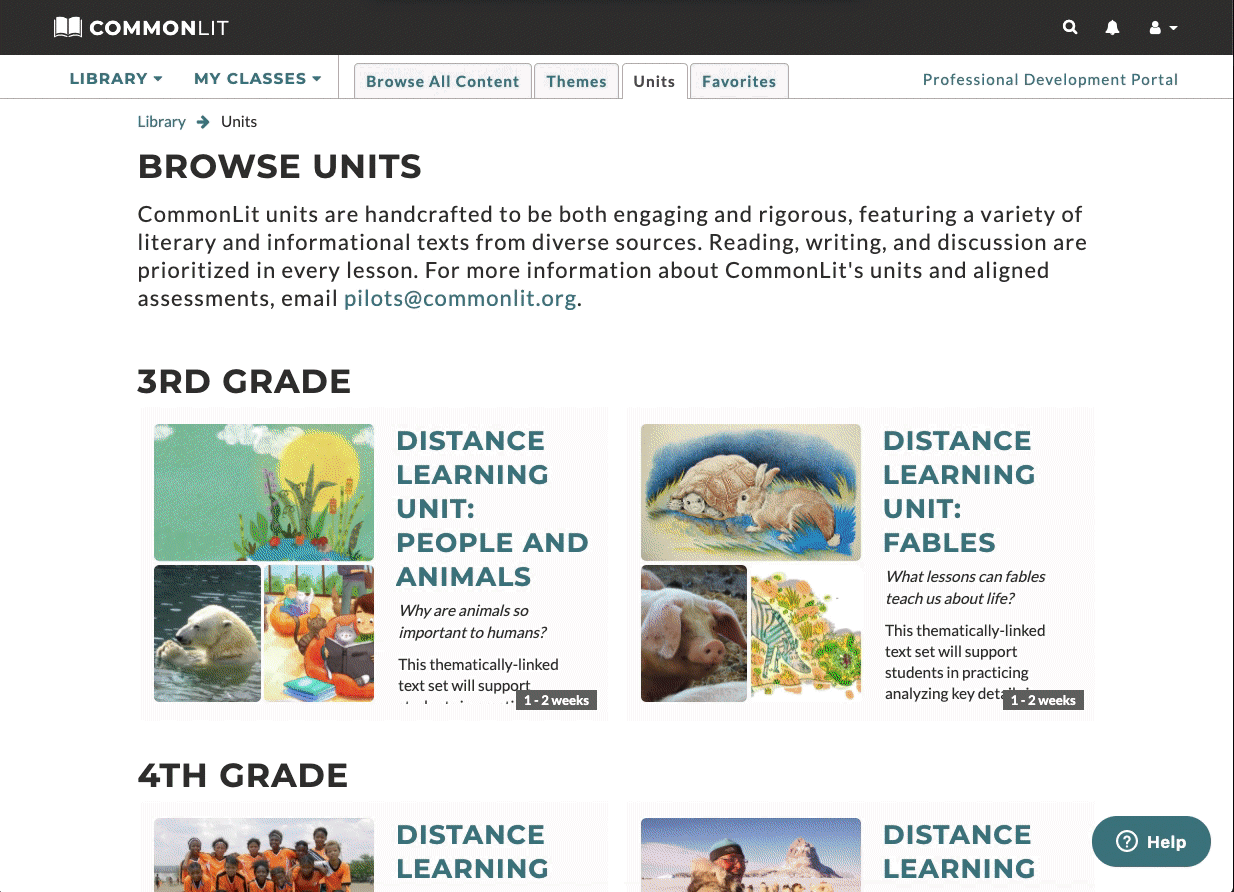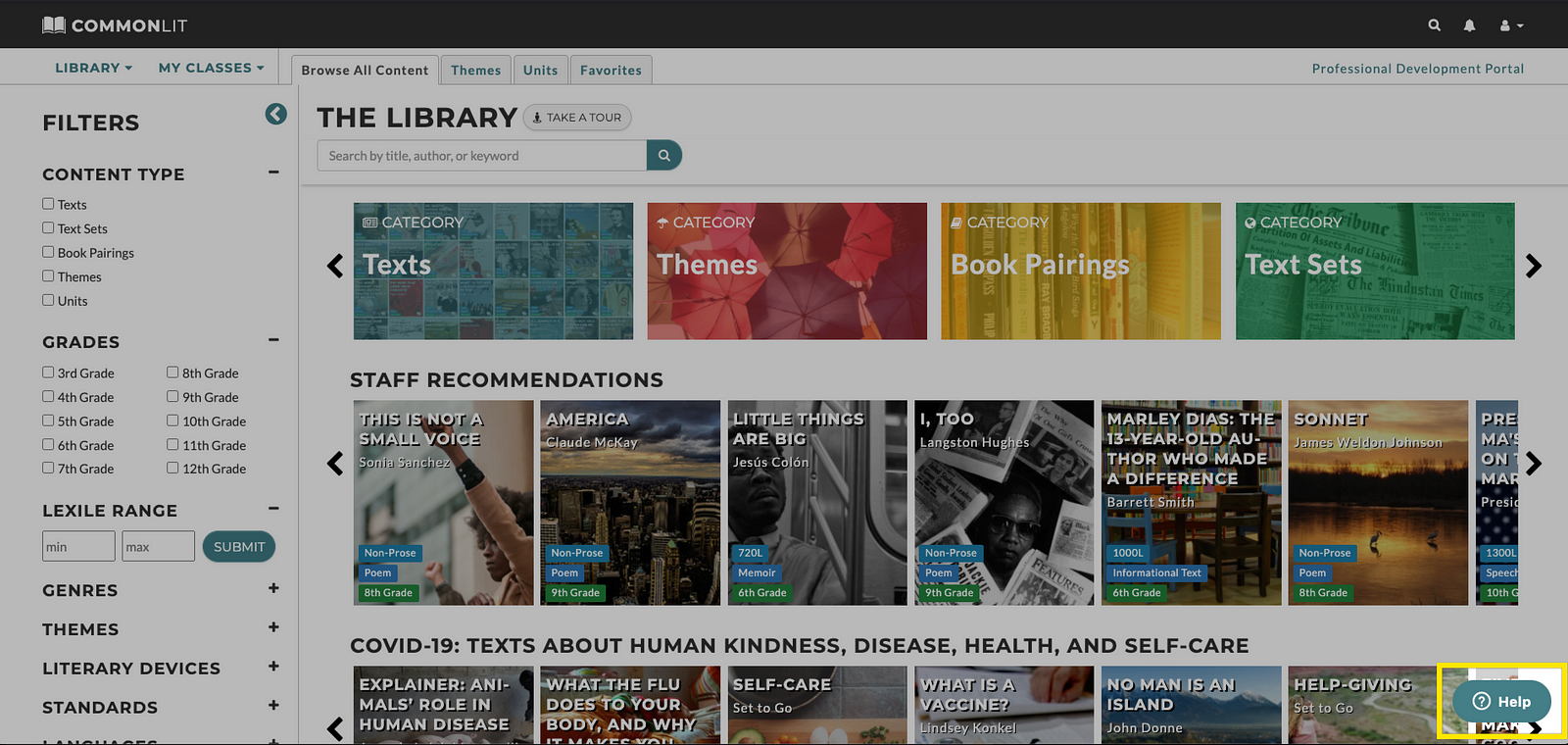We are here for you — our team developed units with high-interest texts, vocabulary activities, and writing lessons for any virtual learning model
CommonLit’s Distance Learning Units were specifically designed to help teachers deal with extended school closures, virtual, synchronous, asynchronous, hybrid learning — and everything in between.
These are shorter units that will last between 1–3 weeks of instructional time, depending on your particular virtual learning context. They include high-interest texts, vocabulary activities, and a culminating essay. All the lessons have been packaged in a way so that can be easily facilitated with remote students either through CommonLit, Google Classroom, and/or their class webpage. Teachers, you are coping with so much; our team hopes these units make your jobs just a little bit easier in the months to come.
To access CommonLit’s Distance Learning Units, login to your CommonLit account and navigate here.

Let’s take a closer look at this 6th Grade Distance Learning Unit, “Being Different.”
Build Academic Vocabulary
The first resource in the unit is a packet of vocabulary activities with academic words that students will encounter again and again throughout the unit. In this 6th grade unit, “Being Different,” students practice using ten words: clamor, conduct, disturb, predict, shame, gesture, grimace, tone, survival, and resemble.
The packet contains five vocabulary activities (fill-in-the-blank, matching, etc.) that become increasingly complex — pushing students to retain the definition of the new word and use it in their writing.
To make things incredibly simple for teachers, we’ve formatted a digital, editable student copy for you. Teachers can simply make a copy of this resource and share this activity with students through Google Docs.
Vocabulary activities are flexible — they work for whole-class and independent work.

Read Texts by Diverse Authors
This 6th grade Distance Learning Unit features four anchor texts that speak to the same theme of being different.
“Fish Cheeks” by Amy Tan
The first text is a short story called “Fish Cheeks” by Amy Tan in which a young Chinese American girl feels ashamed of her family’s foods and traditions during dinner. The narrator confronts complicated feelings of embarrassment for her family’s traditions across the dinner table from her crush, Robert, who does not share her culture. The story provides a window into feelings that young, first generation Americans experience that make them feel different.
“Unusual Normality” by Ishmael Beah
The second text is the short story “Unusual Normality” by Ishmael Beah who was recruited to be a child soldier in Sierra Leone when he was just thirteen years old. The story takes place in the United States where he lived with his foster mother. In the story, a group of boys are impressed by Beah’s paintballing skills, and Beah wonders whether the boys would ever understand why he happens to be so good at shooting.
“Inside Out” by Francisco Jimenez
The third text is a short story called “Inside Out” by Francisco Jimenez. The story follows the narrator, Francisco, a Spanish-speaking first grader, through his first year at an English-only school. As Francisco struggles to communicate with teachers and peers, he ultimately finds a way to build new relationships and communicate through art.
“Drum Dream Girl” by Margarita Engle
The last text is a poem called “Drum Dream Girl” by Margarita Engle, a Cuban-American poet. This rhythmic poem tells the story of a young girl who defied expectations, becoming the first girl to play the drums on the island.
All of these texts will help students answer the culminating essay prompt: Using evidence from the texts you’ve read, explain what it feels like to be different.
Accountable Practice
The heart of the unit are the texts and readings themselves, formatted to give students lots of practice reading, annotating, and writing evidence-based responses.
Each reading lesson has a particular skill focus, designed to help students focus their notetaking. For example, in “Unusual Normality,” the story about the boy soldier, the skill focus reads:
In this lesson, you’ll practice analyzing how an author develops their point of view. This means determining what the author thinks and believes about a person or situation. It also includes examining how specific sections of the text develop the author’s point of view (e.g. through actions, dialogue, or thoughts). As you read, take notes on the author’s point of view about sharing his identity.
After reading, students then complete a short set of multiple-choice and short answer questions aligned to RI.1, point of view — the focus of the lesson. For example, “What is the author’s point of view about sharing details about his background?” or “Which of the following quotations best reveals why the author stayed silent about his life in Africa?”
What’s more, teachers with a free CommonLit account can assign these texts, annotations, and questions through the platform to take advantage of all of the digital features that make distance learning possible.

Flexible Facilitation for Remote, In-Person, Hybrid, Etc.
The best thing about CommonLit’s Distance Learning units is that they are extremely flexible, no matter what situation you’re in. Each lesson can be done completely independently if in-person or synchronous whole-class virtual learning isn’t possible. The lessons can also be converted to a recorded video lesson featuring teacher modeling using this simple guide.
My recommendation would be to introduce the lessons in a short synchronous virtual method with students using Zoom or other video conferencing software. Do a screen share. Introduce the skill focus. Start reading the text aloud. Then, model a few annotations through a Think Aloud. Keep it short — read 2 or 3 paragraphs. Then, let students complete the story on their own time. It might take time for students to find a quiet place for learning. Post a video recording of the introduction for students who were absent or for students who weren’t able to get online. Keep track of student work using the CommonLit teacher dashboard, and be sure to make comments on student annotations to keep motivation high (more on how to do this here).
17 Units to Browse Today

CommonLit has published 17 Distance Learning Units like this one for you to browse today:
GRADE 3
GRADE 4
GRADE 5
GRADE 6
GRADE 7
GRADE 8
GRADE 9
GRADE 10
GRADE 11
GRADE 12
Finally, if you’re new to CommonLit’s digital features, I highly recommend signing up for one of our weekly 1-hour webinars, “Getting Started with CommonLit” which we will be running throughout the fall, multiple times per week, in both English and Spanish. You can register for one of our English webinars here or register for our Spanish webinar here. You’ll learn all of the insider tips for getting the most out of CommonLit’s free service.
And if ever you need help, our incredible customer support team is here to help you.

When you log in, find the HELP button in the lower right corner of the screen to be connected to a live agent over chat. You can also email help@commonlit.org.
Hang in there, teachers. We’re behind you.

